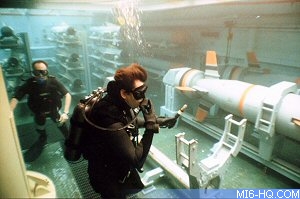 |
| |
MI6 got together with the underwater stunt coordinator
of “Tomorrow Never Dies” Lee Sheward
earlier this week for a chat...
|
|
Lee Sheward Interview - Part 1
6th October 2003
MI6 got together with the underwater stunt coordinator of “Tomorrow
Never Dies” Lee Sheward earlier this week for a chat. He
also performed as a stuntman in “The World Not Enough”.
In this four-part interview we chat about his work on “Tomorrow
Never Dies” and his experience as a stuntman and the future
of the industry.
Starting Out
How long have you been in the stunt business?
Before commencing
work as a stuntman, I performed as a Circus Aerialist touring
the UK. I started work as a stuntman in late
1986, so we're going into 16/17 years now.
What was your first stunt job?
My first stunt job as a stuntman
was on a feature film called “Willow”.
It was over a period of about 10 years before I started to co-ordinate
stunts. Other coordinators I was working for would ask me to
cover the odd day or week of a show they were doing or cover
second unit while they were working main unit.
As for which show I first Coordinated I can’t remember
whether it was a film or a commercial.
Learning to Swim
How did you start out working on under-water units?
Originally
when they were in prep for the film “Tomorrow
Never Dies” I was approached by Dickey Beer who was the
Stunt Supervisor/Coordinator. He asked “was I available
to come in and work along side him and that unit?” At the
time I wasn’t available due to other work commitments but
because I had done a lot of underwater shows before, I made my
recommendations of the performers I recommended he should use.
Because of one thing or another, mainly work, it seemed to
be a very busy year that year. Along with “Tomorrow Never
Dies” there was also “Star Wars” being made
and “Saving Private Ryan”. So there was a shortage
of stunt people. He couldn't get quite the people he wanted on
the first day and poor old Dickey ended up working day and night
because the underwater unit were shooting at night below the
stealth ship set.
So the main unit was shooting during the day and as soon as
they finished and went home upstairs we went into the water and
worked
all night downstairs. Obviously Dickey couldn’t do both
so he rang me back, I jumped ship from the other show I was working
on and took over the coordinating side on the underwater unit.
I spent the next 7 weeks of the summer working all night underwater.
The audio commentary on the DVD talks about all the troubles
with paint flecks, dust, dirt and debris causing havoc with
filming in the tanks. What other factors make the life of an
underwater stunt unit more difficultly compared to usual stunts?
Yeah we put a filter through it, it was a pretty big filter
system seeing as the tank in the 007 stage is a pit in the floor
of the whole construction. For the set they built steel sides
to it, its about 16 feet deep and 250-300 feet long.
The water was warmed because
we were in there up to 7 hours a day underwater, what was
happening was the tank was just reacting to warm water.
We were in there for over 7 weeks so it took time to settle
and it was just a matter of filtering it out.
Even something like filtering debris like balls of paper
as soon as it becomes sodden give it about 5 minutes
and you've got half a hundred weight of papier-mâché floating
around. It’s not just the stunt people and camera
crew underwater there’s lighting crew safety divers,
props men... quite a menagerie of people down there.
Some guys just down there with nets filtering out debris
that shouldn’t have been down there.
|
|
 One Of Our Missiles Is Missing:
Lee Sheward and 007 realise something is not quite
right onboard HMS Devonshire
One Of Our Missiles Is Missing:
Lee Sheward and 007 realise something is not quite
right onboard HMS Devonshire.
DVD Timecode
"Tomorrow Never Dies"
Underwater Rendezvous
01:06:31
|
|
But the main problem with working underwater is communication.
We use a mixture of everything as well as a hydrophone, which
is
an underwater communications system where topside can talk to
everyone in the water.
Sound travels very well through water so everyone hears very
well what is being said, but trying to communicate back doesn’t
work as well. So either hand signals or queuing, tapping on metal
to try and get a sound vibrating through and just watching. When
on land you can obviously shout, use radios or use light que's
- underwater is slightly different so everyone has to pay more
attention to what is going on.
Keep an eye out for the second part of the interview where
we look at responsibilities of a stunt coordinator and Michelle
Yeoh's work on TND.
Many thanks to Lee Sheward.
Related Articles
 Lee
Sheward Interview (2)
Lee
Sheward Interview (2)
 Lee
Sheward Interview (3)
Lee
Sheward Interview (3)
 Lee
Sheward Interview (4)
Lee
Sheward Interview (4)
 MI6 "Tomorrow Never
Dies " Coverage
MI6 "Tomorrow Never
Dies " Coverage